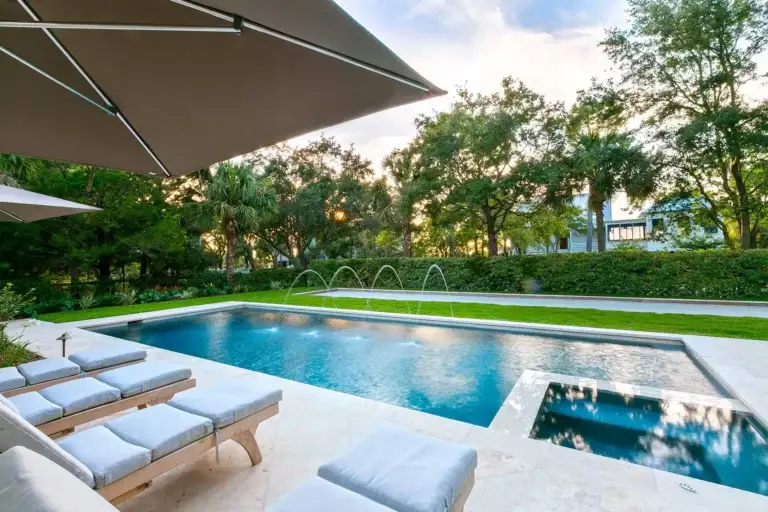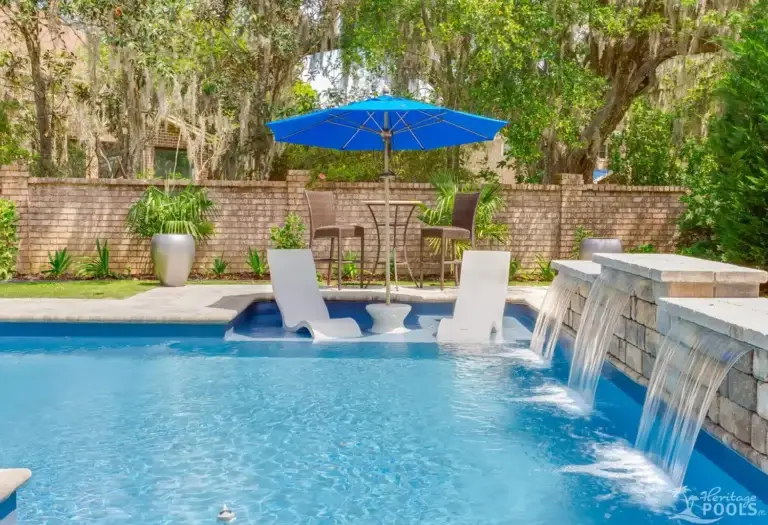Owning a custom in-ground pool in Charleston isn’t just about enjoying luxury. It’s also about maintaining it! A well-maintained pool helps to enhance your property value, ensures swimmer safety and keeps operating costs low. At Heritage Pools, we believe that every dream pool deserves a maintenance plan to match its beauty.
Charleston’s unique coastal climate, with its high humidity and warm temperatures, can accelerate algae growth, cause evaporation and even shift your pool’s chemistry faster than in other regions. That’s why it’s crucial to stick to a consistent, year-round swimming pool maintenance routine tailored to local conditions.
Whether you’re a seasoned pool owner or simply enjoying your first custom design from Heritage Pools, this pool care checklist will help you keep your investment looking and performing its best.
Crystal-clear and ready to impress!
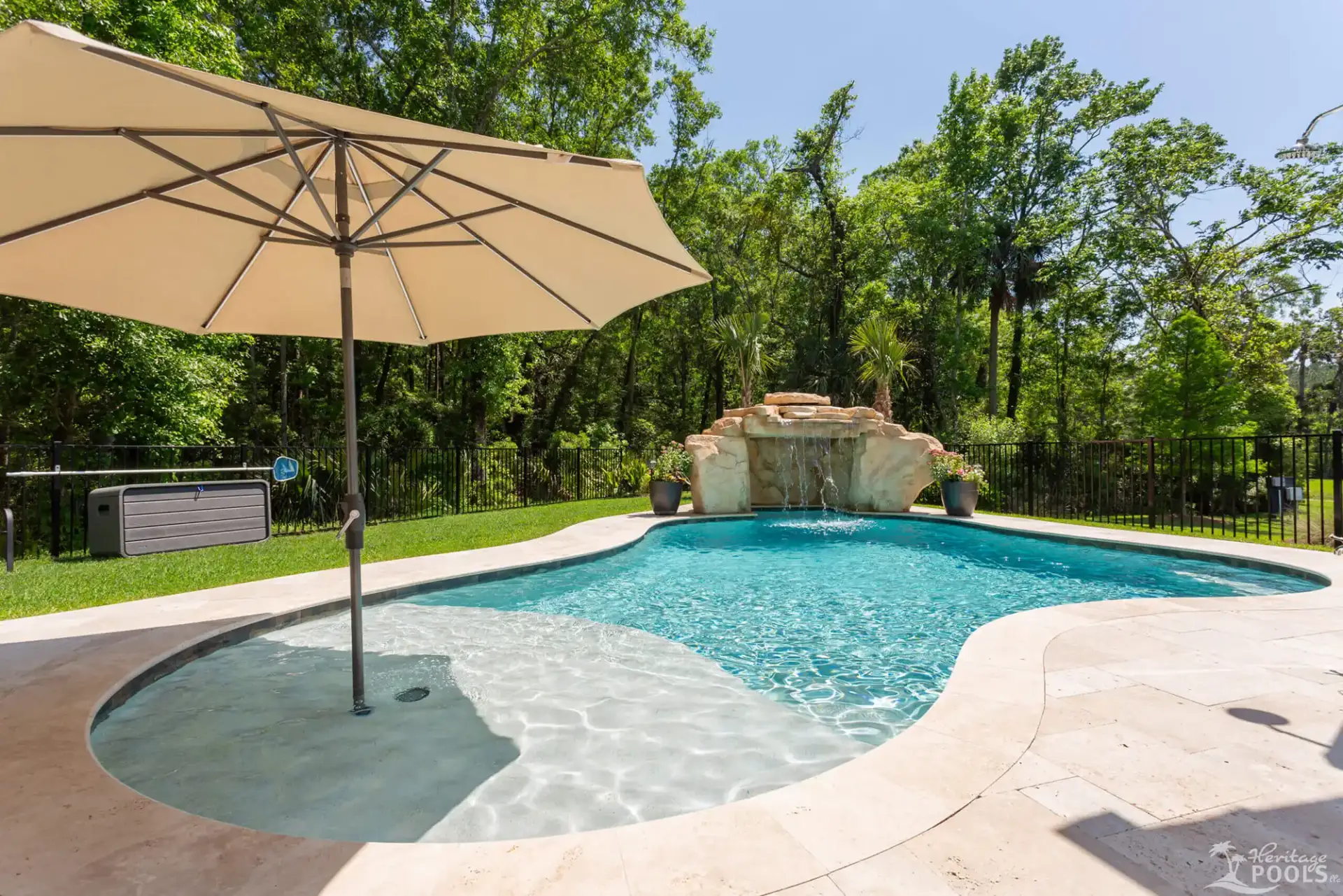
1. Daily Skimming and Surface Cleaning
Don’t let leaves and insects leave your pool looking murky at best. Daily skimming is the first and easiest line of defense against contamination.
Floating debris like leaves, pollen and bugs aren’t just unsightly, they also contribute to algae formation and affect the pool’s water chemistry. Using a handheld skimmer or automated surface cleaner, spend a few minutes each day to remove debris before it sinks to the bottom.
Keeping the pool deck clear is just as important. Wind and foot traffic bring in dirt, grass and grime that can quickly find their way into the water. A clean surrounding means less cleaning later.
Pro Tip: Install a leaf net during fall or after storms to reduce maintenance time dramatically.
2. Brushing Pool Walls and Tiles
A clean surface equals a clean pool. Brushing is essential to prevent calcium deposits, metal corrosion and algae buildup on your pool walls, tiles and floor.
Use a nylon brush for vinyl or fiberglass pools and a stainless steel and nylon mix brush for concrete surfaces. Using a brush that is just stainless steel on concrete can be very aggressive and even cause damage in time, which is why we recommend a stainless steel and nylon mix. Also, pay special attention to areas with poor circulation, such as behind ladders, under pool lights or in tight corners.
This manual action physically breaks down grime and allows your circulatory system (the filter and pump) to do the heavy lifting afterward. Brushing two to three times a week can significantly reduce the need for algaecide and chlorine shock.
3. Vacuuming the Pool Weekly
Once your pool is brushed, it’s time to vacuum the debris. There are three main types:
| Type | Description | Best For |
|---|---|---|
| Manual Vacuum | Budget-friendly but labor-intensive | Smaller or basic pools |
| Suction Cleaner | Connects to skimmer; uses existing pump system | Medium-sized pools |
| Robotic Cleaner | Fully automated, energy-efficient | Larger or high-traffic pools |
Manual vacuums are excellent for spot cleaning, but robotic cleaners offer superior energy efficiency and convenience – ideal for Charleston’s busy families. Always vacuum after brushing and before shocking the pool to get the most out of your chemicals.
4. Monitor and Maintain Proper Water Levels
Water volume affects everything from pump pressure to chemical balance. Your water level should be at the center of the pool skimmer for optimal performance.
A fluctuating water line can strain your filtration equipment and disrupt the circulatory system, leading to unexpected maintenance costs.
5. Test and Balance Your Pool Chemistry

A sparkling pool starts with proper chemistry. Here’s what to test weekly:
- pH Level (7.2 – 7.8) – Ensures swimmer comfort and chlorine effectiveness.
- Chlorine or Bromine – Disinfects and kills bacteria.
- Alkalinity (80-120 ppm) – Stabilizes pH fluctuations.
- Calcium Hardness (200-400 ppm) – Prevents surface damage and corrosion.
- Cyanuric Acid (30-50 ppm) – Protects chlorine from UV breakdown.
Charleston’s mineral-rich water can throw your levels off balance, so regular testing with strips or digital readers is a must. Don’t forget to test after heavy rainfall, which dilutes chemical concentrations.
Tip: Use a mobile pool app to log your results and automate reminders.
6. Shock the Pool to Eliminate Contaminants
Shocking isn’t just for emergencies. It’s a routine maintenance essential! It oxidizes organic matter, kills bacteria and even resets chlorine levels.
Use a chlorine shock after:
- Pool parties or heavy usage
- Rainstorms
- Algae sightings
- Weekly, as part of regular pool care
Dissolve shock in a bucket before adding it to the pool to avoid bleaching the liner. Keep the pump running overnight for full circulation and allow the chlorine level to return to safe levels before swimming.
7. Clean and Maintain Your Pool Filter
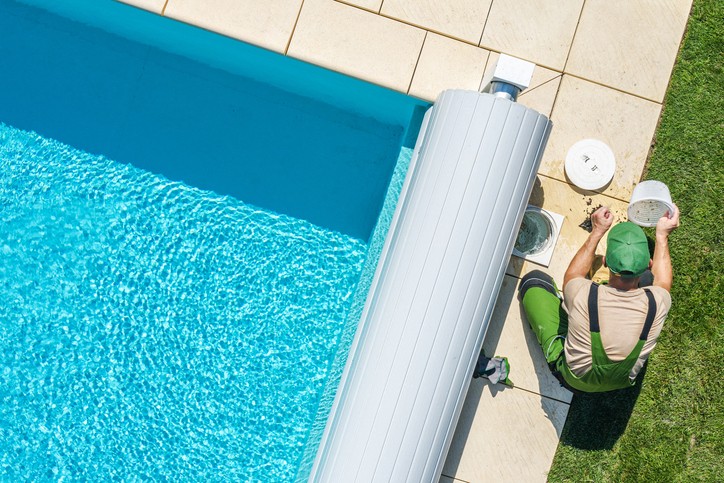
Your filter is the heart of your pool’s cleaning system. Depending on the type, maintenance will vary:
- Sand Filters – Backwash every 1–2 weeks and replace sand every 5 years.
- Cartridge Filters – Rinse monthly, replace annually.
- Diatomaceous Earth (DE) Filters – Backwash monthly, recoat with DE powder.
When pressure gauge readings increase by 8–10 psi over normal, it’s time to clean. Neglecting this step can cause cloudy water and damage your pump system.
8. Inspect Pool Equipment Regularly
Even the best-designed pools need consistent mechanical checks. Heritage Pools builds with premium-grade components, but staying proactive extends equipment life and prevents costly repairs.
Inspect:
- Pump baskets and skimmers for clogs
- Empty skimmer baskets every two days
- Timers and automation panels for accuracy
- Heating systems for temperature consistency
At Heritage Pools, we recommend emptying your skimmer baskets every two days. If you have a high-debris pool and you don’t keep an eye on it, you might end up with a green pool instead!
Use Heritage’s maintenance services if you’re unsure about proper equipment handling – we handle all the dirty work, so you can enjoy a pristine pool.
9. Maintain Pool Surroundings
Your pool’s environment plays a major role in water quality. Loose landscaping or trees that shed leaves can add debris and affect chemical levels.
Tips for optimal surroundings can include:
- Use non-shedding plants
- Add drainage away from the pool
- Pressure wash decks to prevent slipping hazards
- Install barriers to keep out pets or wildlife
Maintaining the surroundings also contributes to pool safety and reduces the chance of accidents or contamination.
10. Prepare for Seasonal Changes
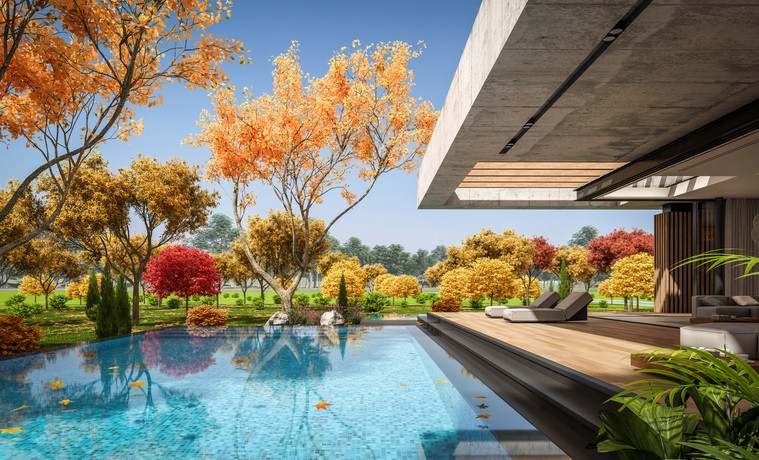
Charleston’s mild winters don’t mean you can skip seasonal prep. Winterizing your pool preserves water chemistry, equipment and surface integrity.
Winterize your swimming pool in four simple steps:
- Balance chemical levels
- Lower water below skimmer
- Add winterizing algaecide
- Cover the pool securely
If you cover your pool in the winter, you’ll still need to check the water, add chemicals and maintain your pool. If you cover your pool all winter and don’t check the water, chances are that the water will turn green. Not only that, but it’s often more expensive to clear it than to just maintain it.
When spring returns, reverse the process carefully to avoid overcorrection in your pool’s chemistry. A clean reopen starts with our professional startup services at Heritage Pools.
Frequently Asked Questions
How often should I clean my pool filter?
It depends on the type. Sand filters need backwashing every one to two weeks, while cartridge filters require monthly rinsing and annual replacement.
Is saltwater better than chlorine for Charleston pools?
Salt systems are more stable in warm climates, reducing the need for manual chlorine. However, they require special maintenance like cell cleaning and scale prevention.
What’s the best way to prevent algae in Charleston’s humidity?
Consistent brushing, balanced chemicals, and occasional shocking are key. Also, run your pump long enough daily to circulate all the water.
Do I need a professional pool service if I follow this checklist?
DIY maintenance covers the basics, but annual professional inspections help detect hidden issues early, especially with pumps, heaters and automation systems.
Why is my pool water cloudy even though I maintain it?
Check filtration first. Dirty filters, inadequate circulation or low sanitizer levels are the most common culprits.
Enjoy Every Swim With Heritage Pools
A clean, healthy pool doesn’t just happen. It’s built with daily habits, seasonal awareness and professional support. Whether you’re caring for your newly installed Heritage I-Beam Pool™, a fiberglass beauty or a custom concrete design, this checklist ensures your investment stays as breathtaking as day one.
Let Charleston’s leading pool builder Heritage Pools handle the tough parts while you enjoy every splash. Contact us today to schedule a maintenance consultation or explore our expert pool renovations and cleaning services.
